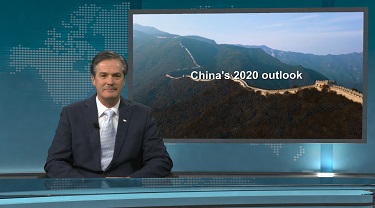Eyes are riveted on China at the moment. Its extraordinary 40-year expansion is now facing some of the greatest headwinds it has encountered over that entire period. Growth is at its slowest point in 29 years. Exports are being impeded by United States tariffs. Debt levels have ballooned, raising concerns about financial stability. Political stability has been tested by the resilient protest movement in Hong Kong. Food supplies are being compromised by the devastating impact on China’s extensive pig population of the African swine flu (ASF). And if these weren’t enough, China is grappling with a coronavirus outbreak in the city of Wuhan. Bearing all of this in mind, what is the outlook for China in 2020?
The starting point isn’t great. Deceleration was the big story throughout 2019, and the causes of slower growth haven’t really gone away. Recent data ignited the hopes of some analysts: industrial production, fixed asset investment, inflation-adjusted retail sales, imports and the prescient purchasing managers’ indexes all posted increases, which were ahead of market expectations. While a pleasant surprise, the uptick in these indicators isn’t likely to last. Weak income and credit growth, bloated real estate inventories and outright declines in other key barometers of activity suggest further weakness.
At a roundtable discussion in Ottawa last week, panellists were asked to address China’s 2020 outlook through the lens of four questions. Here are the questions, and the answers I offered:
What is one thing that will change in 2020? Clearly, it’s China’s relationship with the United States. Many breathed a sigh of relief at the signing of the Stage-1 trade deal on Jan. 15. The deal ushers the two sides into at least two years of managed trade, a truce that stems the rise in tariffs and eked out a small, symbolic tariff reduction. Inroads were made on the issues of intellectual property, technology transfer, financial services, currency manipulation, and the thorny agriculture sector—all points of long-standing irritation on the U.S. side. It’s an impressive list, but many of the considerations were already agreed at the World Trade Organization, so it’s hard to see what is net-new, and how it’ll be implemented and enforced. Time will tell. As it stands, it is clearly not a free trade deal, and doesn’t address U.S. concerns regarding state-owned enterprises, industrial subsidies and cyber security. Most importantly, it leaves the most punitive U.S. tariffs in place, meaning the key threat to Chinese—and indeed, global growth—is still there.
What will not change? China’s growing need for goods and services from the rest of the world remains intact. Rising domestic wealth means that the ongoing transformation from a trade-based to a consumption-led economy continues. This may well be magnified in the year ahead as the true effects of ASF on overall food supplies and prices is fully realized. Those with established export ties to China are in for another good year.
What will be under-reported? China’s overall debt load and general credit conditions are becoming more transparent over time. Even so, revealing the entire scope of a debt situation that is large and far-reaching can easily undermine confidence in overall financial stability, something that is closely guarded in every economy. Progress is being made in that defaults are being allowed to occur, but the extent of defaults in the last two years has been nothing if not alarming. Thankfully, this has caused authorities to put more stringent control on credit extension. Unfortunately, the deceleration in growth has made it more difficult to “grow out” of the problem.
What will be over-hyped? The China 2025 program and their ambitious Belt and Road infrastructure initiative are sure to be prominent in domestic and international discourse. These will likely be used to further stoke a wave of neo-nationalism which certain analysts are profiling, and to deflect attention from some of the immediate growth-woes of the Chinese economy.
This year might be one where China muddles through a phase of slower growth, while hammering out their 13th five-year plan. Resolution of the tariff issue would go a long way to restoring steadier growth, but achievement of a more substantive trade agreement will be complicated this year by the U.S. electoral cycle. For China’s economy, 2020 is going to be a delicate one.
The bottom line?
China still depends on international trade and slower, policy-inhibited global growth will weigh directly and indirectly on China’s 2020 fortunes. Resolution couldn’t come soon enough.
This commentary is presented for informational purposes only. It’s not intended to be a comprehensive or detailed statement on any subject and no representations or warranties, express or implied, are made as to its accuracy, timeliness or completeness. Nothing in this commentary is intended to provide financial, legal, accounting or tax advice nor should it be relied upon. EDC nor the author is liable whatsoever for any loss or damage caused by, or resulting from, any use of or any inaccuracies, errors or omissions in the information provided.





